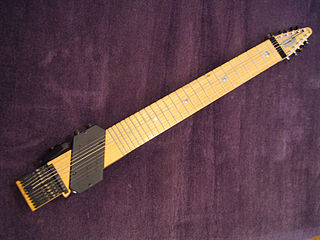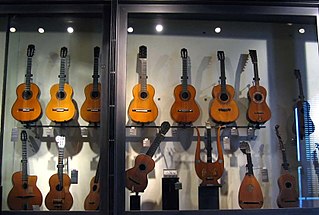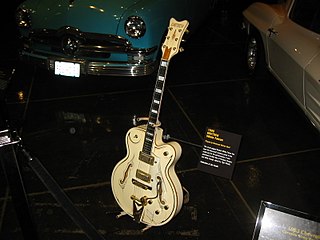
The bass guitar, electric bass or simply bass is the lowest-pitched member of the guitar family. It is a plucked string instrument similar in appearance and construction to an electric or acoustic guitar, but with a longer neck and scale length, and typically four to six strings or courses. Since the mid-1950s, the bass guitar has largely replaced the double bass in popular music.

An electric guitar is a guitar that requires external amplification in order to be heard at typical performance volumes, unlike a standard acoustic guitar. It uses one or more pickups to convert the vibration of its strings into electrical signals, which ultimately are reproduced as sound by loudspeakers. The sound is sometimes shaped or electronically altered to achieve different timbres or tonal qualities from that of an acoustic guitar via amplifier settings or knobs on the guitar. Often, this is done through the use of effects such as reverb, distortion and "overdrive"; the latter is considered to be a key element of electric blues guitar music and jazz and rock guitar playing. Designs also exist combining attributes of the electric and acoustic guitars: the semi-acoustic and acoustic-electric guitars.

String instruments, stringed instruments, or chordophones are musical instruments that produce sound from vibrating strings when a performer plays or sounds the strings in some manner.

The Chapman Stick is an electric musical instrument devised by Emmett Chapman in the early 1970s. A member of the guitar family, the Chapman Stick usually has ten or twelve individually tuned strings and is used to play bass lines, melody lines, chords, or textures. Designed as a fully polyphonic chordal instrument, it can also cover several of these musical parts simultaneously.

Tapping is a playing technique that can be used on any stringed instrument, but which is most commonly used on guitar. The technique involves a string being fretted and set into vibration as part of a single motion. This is in contrast to standard techniques that involve fretting with one hand and picking with the other. Tapping is the primary technique intended for instruments such as the Chapman Stick.

An autoharp or chord zither is a string instrument belonging to the zither family. It uses a series of bars individually configured to mute all strings other than those needed for the intended chord. The term autoharp was once a trademark of the Oscar Schmidt company, but has become a generic designation for all such instruments, regardless of manufacturer.

A humbucker, humbucking pickup or double coil is a guitar pickup that uses two wire coils to cancel out the noisy interference picked up by coil pickups. Humbucking coils are also used in dynamic microphones to cancel electromagnetic hum. Humbuckers are one of the two main types of guitar pickups. The other is single coil.

A twelve-string guitar is a steel-string guitar with 12 strings in six courses, which produces a thicker, more ringing tone than a standard six-string guitar. Typically, the strings of the lower four courses are tuned in octaves, with those of the upper two courses tuned in unison. The gap between the strings within each dual-string course is narrow, and the strings of each course are fretted and plucked as a single unit. The neck is wider, to accommodate the extra strings, and is similar to the width of a classical guitar neck. The sound, particularly on acoustic instruments, is fuller and more harmonically resonant than six-string instruments. The 12-string guitar can be played like a 6-string guitar as players still use the same notes, chords and guitar techniques like a standard 6-string guitar, but advanced techniques might be tough as players need to play or pluck two strings simultaneously.

Gretsch is an American company that manufactures musical instruments. The company was founded in 1883 in Brooklyn, New York by Friedrich Gretsch, a 27-year-old German immigrant, shortly after his arrival to the United States. Friedrich Gretsch manufactured banjos, tambourines, and drums until his death in 1895. In 1916, his son, Fred Gretsch Sr. moved operations to a larger facility where Gretsch went on to become a prominent manufacturer of American musical instruments. Through the years, Gretsch has manufactured a wide range of instruments, though they currently focus on electric, acoustic and resonator guitars, basses, ukuleles, and drums.

The following outline is provided as an overview of and topical guide to guitars:
Tap guitar is a class of guitar that is played primarily by tapping on the strings. Any guitar can be played this way, but there are various specialty brands of instruments that are designed specifically for this technique.

A guitar controller is a video game controller designed to simulate the playing of the guitar, a string musical instrument. Guitar controllers are often used for music games such as UmJammer Lammy: NOW!, GuitarFreaks, Guitar Hero, and the Rock Band series. The controllers are played by holding down a colored fret button that matches a colored, on-screen note, while pressing the strum bar as the note passes through the target. The controllers also feature a whammy bar, which is used to bend notes and collect each game's equivalent of bonus energy. Different games and models of controllers have introduced additional features, such as effects switches, additional fret buttons, and fret touch pads. The fret buttons are colored usually in the order of green, red, yellow, blue, and orange.

The Gretsch White Falcon is an electric hollow-body guitar introduced in 1954 by Gretsch.
The Megatar is a stringed musical instrument designed to be played using a two-handed tapping technique. It is manufactured by the American company Mobius Megatar.

Robin Guitars was a boutique manufacturing company that produced electric guitars. The company was located in Houston, Texas.

Experimental luthiers are luthiers who take part in alternative stringed instrument manufacturing or create original string instruments altogether.
The Fender Telecaster, colloquially known as the Tele, is an electric guitar produced by Fender. Together with its sister model the Esquire, it was the world's first mass-produced, commercially successful solid-body electric guitar. Its simple yet effective design and revolutionary sound broke ground and set trends in electric guitar manufacturing and popular music.

The Warr Guitar is an American-made touch guitar, a type of instrument that combines both bass and melodic strings on a single fretboard. Invented by Mark Warr, a musician from Thousand Oaks, California, it is related to the Chapman Stick, another two-handed tapping instrument. The Warr guitar is designed for either two-handed tapping or strumming. Warr guitars have between seven and 14 strings.

The Bunker Touch Guitar is a double-necked touch guitar developed by Dave Bunker.

















